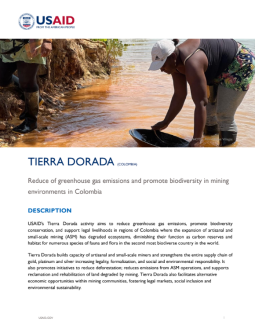DESCRIPTION
USAID’s Tierra Dorada activity aims to reduce greenhouse gas emissions, promote biodiversity conservation, and support legal livelihoods in regions of Colombia where the expansion of artisanal and small-scale mining (ASM) has degraded ecosystems, diminishing their function as carbon reserves and habitat for numerous species of fauna and flora in the second most biodiverse country in the world.
Tierra Dorada builds capacity of artisanal and small-scale miners and strengthens the entire supply chain of gold, platinum and silver increasing legality, formalization, and social and environmental responsibility. It also promotes initiatives to reduce deforestation; reduces emissions from ASM operations, and supports reclamation and rehabilitation of land degraded by mining. Tierra Dorada also facilitates alternative economic opportunities within mining communities, fostering legal markets, social inclusion and environmental sustainability.
Tierra Dorada focuses on the departments of Antioquia, Chocó, and Bolívar, in which 78% of Colombia’s national gold production is concentrated. Furthermore, Tierra Dorada creates synergies with public entities, private sector, and civil society organizations to meet conservation and climate change mitigation objectives and to contribute to sustainable economic development, sector governance, and peace.
OBJECTIVES
Improved ecosystem services and conservation in areas affected by illegal and informal Artisanal and Small Scale Mining (ASM)
This objective improves ecosystem services delivery and biodiversity conservation by preventing, reducing, and rehabilitating the environmental damage produced by informal and illegal ASM, including:
1) Increased and scaled-up reclamation and rehabilitation of ASM-degraded landscapes
2) Improved environmentally-friendly alternative livelihoods ; and
3) Prevented and reduced environmental impacts and threats to biodiversity from illegal and informal ASM.
Strengthened responsibility and lawfulness of asm activities throughout the supply chain of gold and targeted minerals
This objective takes a holistic approach to promoting responsible and legal mining through:
1) Improved regulatory frameworks and enabling mechanisms for the governance of ASM
2) Increased legalization, formalization, and business building of ASM operations
3) Improved traceability of responsibly sourced minerals; and
4) Increased access to international markets for responsible ASM.
EXPECTED RESULTS
- Reduction of greenhouse gas emissions caused by deforestation for informal ASM gold mining operations. Rehabilitation of 15,000 hectares of degraded mining lands.
- 300,000 hectares with improved natural resources in six conservation corridors established for biodiversity protection.
- Greater economic opportunities for 1,500 households from rural mining communities in agriculture, service sector and formal mining to reduce the ASM pressure in the environment.
- 135 civil society organizations and miner associations strengthened to undertake mining and no-mining business in accordance with national and international standards. 11.200 persons trained enhance their skills on natural resources management, livelihoods and/or mining formalization.
- New mechanisms facilitate governance and the entry of ASM miners and actors in the supply chain into the formal economy.
- Three Regional Service Centers support ASM units to introduce mercury-free technologies, increase productivity, integrate into traceable supply chains, and access international markets.
- Solid communication strategy to raise awareness about the benefits of responsible mining among all the actors along the mining supply chain.

